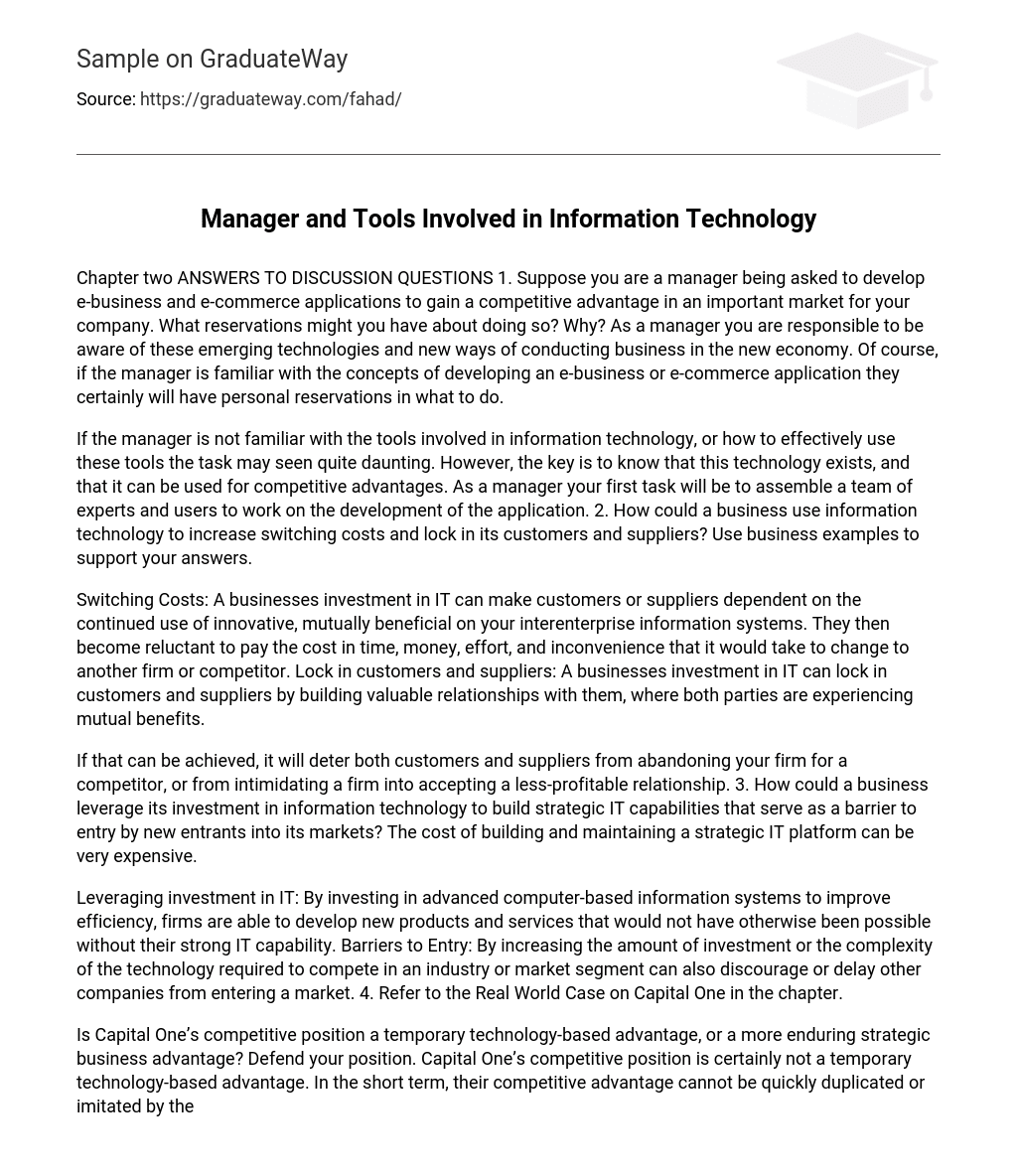Suppose you are a manager being asked to develop e-business and e-commerce applications to gain a competitive advantage in an important market for your company. What reservations might you have about doing so? Why?
As a manager you are responsible to be aware of these emerging technologies and new ways of conducting business in the new economy. Of course, if the manager is familiar with the concepts of developing an e-business or e-commerce application they certainly will have personal reservations in what to do.
If the manager is not familiar with the tools involved in information technology, or how to effectively use these tools the task may seen quite daunting. However, the key is to know that this technology exists, and that it can be used for competitive advantages. As a manager your first task will be to assemble a team of experts and users to work on the development of the application.
How could a business use information technology to increase switching costs and lock in its customers and suppliers?
Switching Costs: A businesses investment in IT can make customers or suppliers dependent on the continued use of innovative, mutually beneficial on your interenterprise information systems. They then become reluctant to pay the cost in time, money, effort, and inconvenience that it would take to change to another firm or competitor.
Lock in customers and suppliers: A businesses investment in IT can lock in customers and suppliers by building valuable relationships with them, where both parties are experiencing mutual benefits. If that can be achieved, it will deter both customers and suppliers from abandoning your firm for a competitor, or from intimidating a firm into accepting a less-profitable relationship.
How could a business leverage its investment in information technology to build strategic IT capabilities that serve as a barrier to entry by new entrants into its markets?
The cost of building and maintaining a strategic IT platform can be very expensive.
Leveraging investment in IT: By investing in advanced computer-based information systems to improve efficiency, firms are able to develop new products and services that would not have otherwise been possible without their strong IT capability.
Barriers to Entry: By increasing the amount of investment or the complexity of the technology required to compete in an industry or market segment can also discourage or delay other companies from entering a market.
Refer to the Real World Case on Capital One in the chapter. Is Capital One’s competitive position a temporary technology-based advantage, or a more enduring strategic business advantage?
Capital One’s competitive position is certainly not a temporary technology-based advantage. In the short term, their competitive advantage cannot be quickly duplicated or imitated by their competitors. Although in the long term competitors will be able to duplicate the use of this technology, it will require massive amounts of capital, a steep learning curve, and lengthy periods of time to amass that amount of information.
As such, Capital One has a more enduring strategic business advantage. The major challenge will be for the competition to “catch-up” to Capital One while at the same time Capital One will continue to forge ahead with new initiatives and innovations.
What strategic role can information technology play in business process reengineering and total quality management?
Information technology can play a vital role in BPR and TQM. Using the technology involved in BPR, an organization can achieve dramatic improvements in areas such as cost, quality, speed and service.
Information technology can also be used to enable a firm to gain improvements in areas such as product quality, productivity, flexibility, timeliness, and customer responsiveness. Thus, the use of technology in BPR and TQM can result in improvements in the standard way of conducting business.
How can information technology help a business form strategic alliances with its customers, suppliers, and others?
Information technology can help a business form strategic alliances with its customers, suppliers, competitors, consultants, and other companies (mergers, acquisitions, joint ventures, and virtual companies).
These new business linkages and alliances help firms to communicate, collaborate, and share information in ways that were never possible. By establishing strategic alliances, organizations are able to provide better quality products and services to their customers in a more efficient manner, responsive, and flexible manner.
How could a business use the Internet technologies to form a virtual company, or become an agile competitor?
Agile companies depend heavily on information technology to:
- Enrich its customers with customized solutions to their needs.
- Cooperate with other businesses to bring products to market as rapidly and cost-efficiently as possible.
- Combine the flexible, multiple organizational structures it uses.
- Leverage the competitive impact of its people and information resources.





